The foregoing describes Harkness' success with which program in the ECAC? Cornell? Or, could it be RPI? Or, perhaps even Union? The answers are all correct. Perhaps like no other, Ned Harkness has shaped intimately and intricately the history of the ECAC through his involvement with two of its historic programs, and a recently successful and assertive third program.
The relationships between Ned Harkness and hockey at RPI, Cornell, and Union has shaped the landscape of the ECAC for generations while his approaches to the collegiate game effected great change in the college hockey landscape. The programs that Harkness helped build have produced four national championships, 14 Frozen-Four appearances, 16 ECAC Championships, and 15 ECAC regular-season titles. Nearly a third of all ECAC Championships that have been won and Frozen-Four berths that ECAC programs have earned are by programs that Harkness led during its crucial developmental stages. Cornell and RPI account for four of the ECAC's five national championships. Harkness personally led the Big Red and the Engineers to three of those championships.
In many ways, the greatest that is ECAC Hockey can be traced to Harkness and the indelible impression he left upon hockey at Cornell, RPI, and Union. That is why weekend series between RPI and Union, and Cornell are no ordinary series as they represent clashes of the programs that were created by a common vision; that of Ned Harkness.
The history of Ned Harkness' contributions to programs in the ECAC began before there was an ECAC that sponsored intercollegiate hockey contests. Hockey had existed at the research institution in Troy for over four decades when Ned Harkness arrived. The program was on hiatus beginning in 1938, but Harkness did not bring hockey to RPI. However, he made it what it is to the community at RPI today.
Harkness longest time behind the bench for one collegiate program was at RPI. The legendary coach led the Engineers through 14 seasons of hockey. He wore what would become an iconic image of a dusty, old, simple ball cap while coaching his team in practice. This trend became a superstition of sorts. He continued it through the era of his greatest collegiate hockey triumphs. Who could blame him?
When Harkness began coaching in 1949 at RPI, the Engineers had not played a game at home in over a decade. The Engineers would play in a converted military warehouse that the Institute had acquired after the conclusion of the Second World War. They have not left since then. That warehouse became Houston Field House where Harkness would awaken the sleeping giant of Engineer hockey and make RPI one of the very few technical institutes that have a national presence in a major college sport.
It took Harkness four seasons to make an appearance in the NCAA Tournament. The NCAA Tournament had begun just five years before Harkness led the Engineers to their first appearance. The challengers from the East met Minnesota in the first round of the 1953 NCAA Tournament. The Gophers defeated the Engineers 3-2. Harkness would have his revenge. It would take just over one year, but Harkness led the Engineers back to the NCAA Tournament in 1954. RPI defeated Michigan and moved on to confront the Gophers for the second year in a row. It took an extra frame of hockey but Harkness' Engineers defeated Minnesota 5-4.
Harkness would again return to the NCAA Tournament with the Engineers of Troy, but in that last appearance, ultimate glory would not be theirs. One season before the ECAC began sponsoring hockey, St. Lawrence defeated RPI in the first round of the 1961 NCAA Tournament. Harkness would remain at RPI for only two more seasons.
The ECAC crowned its first champion in 1962. With hindsight, one would assume that Harkness led his dominant Engineers that had within the decade proven themselves to be one of the best programs in the nation through the first seasons of ECAC Hockey with much success. The opposite is quite true for the two seasons that Harkness coached the Engineers in the ECAC.
RPI earned a berth into the quarterfinals of the inaugural ECAC Tournament in 1962. The Engineers confronted Colby College; the small liberal arts college from Waterville, ME. The Mules of Colby defeated RPI 7-6. The Engineers unceremoniously exited the first-ever ECAC Tournament prematurely under the leadership of Harkness. The next season was no better. In an era when not every program received an automatic bid to the ECAC Tournament, the last Harkness-coached Engineer squad missed the ECAC playoffs.
The next move that Harkness would make was to Cornell. He would then jump to the Detroit Red Wings of the NHL. He was the first college hockey coach to make such a jump from the collegiate ranks to the NHL. This is a path that would later be taken by other such transformative and legendary coaches including Herb Brooks.
Harkness began the practice of recruiting Canadian talent to build winning traditions at the college hockey programs he coached. This began at RPI and helped lead the Engineers to three NCAA Tournament appearances and one national championship. It was perfected at Cornell when Harkness' practice brought to Cornell players who are now legends at all levels of the game. When Harkness was brought back to the collegiate ranks after his stint in the NHL, he continued this practice at Union College.
Harkness' last position as a head coach of a college hockey program ended near where it began. Harkness returned to the Capital District, but this time it was to begin a hockey program at Union College. Union had sponsored hockey briefly and sporadically between 1903 and 1939. President Bonner of Union College contacted Ned Harkness. He offered Harkness the head coaching position of the newly re-established Union hockey program. Hockey had been absent from Union for nearly four decades. Harkness was to lay the foundations for a program that many hoped would become successful.
Harkness began building the program as he knew how. He recruited heavily from Canada. The culture of historic yet small and somewhat isolated Union College was abraded by the arrival of student-athletes that many of the students who attended the liberal arts college viewed as being recruited not for their scholastic merits, but for their athletic skill. These Canadian imports were held in contempt by many students and created an animosity between some factions of the students of Union College, some alumni of Union, and the hockey program. Harkness drew ire within the College and from such communities by extension as the cause of the arrival of student-athletes to campus.
Many at Union, conceiving of themselves as a historical liberal arts haven, chafed at the notion that students were recruited to represent their alma mater in intercollegiate clashes. The Union community had to grapple with the tension of whether sponsoring athletic programs caused necessarily a sacrifice of academic principles. It took a generation for Union to begin to arrive at a conclusion about this very question, but it was Harkness and Union's hockey program that brought it to the forefront. This tension is forever a part of Harkness' legacy at Union as well as the history of hockey at Union College.
Despite petitions and demonstrations that questioned the value of student-athletes and an intercollegiate hockey program, Harkness continued much as he had at RPI and Cornell. He did what he did best. The task at Union had a unique element. Not only was Harkness tasked with building the program, he was charged with the responsibility of overseeing the construction of a rink in which Union's program would play.
Harkness oversaw the construction of the present-day Messa Rink in the spring before the 1975-76 season, his first season at Union. Harkness' input and design affected the development of some of the features of Messa. It is unclear how much of and which aspects of Messa Harkness affected, but he tirelessly oversaw the construction of Union's first indoor hockey home and doubtlessly had influence in the design beyond desiring a 3,000-seat capacity, modern scoreboard, and locker room with a modern sound system.
Harkness scheduled games against 24 NCAA Division I programs for his first season as Union's bench boss in 1975-76. Union began its Harkness era with a win over a Northeastern in overtime. Harkness' coaching abilities would shine much brighter later in the season. Union met future ECAC opponent Clarkson later in the season. The Golden Knights were ranked second in the nation. Union was regarded highly as the underdog. Predictably, Union lost that game by a margin of 9-3.
Having lost to one team ranked second in the nation, Harkness' first Union team needed to confront another. New Hampshire had risen to the rank of second in the nation and had lost only two games to NCAA Division I programs. New Hampshire had agreed to travel to Union's new rink. Union hosted the Wildcats at Messa Rink, Achilles Rink as it was known then. What resulted was the most significant win in Union hockey history until the 2009-10 season and it remains one of the most significant wins in Union hockey history. Union defeated and upset in spectacular fashion the Wildcats of New Hampshire with a final score of 8-4.
Harkness had achieved greatness at yet another New York-based university. He would remain for only two more seasons at Union. He then would depart from the College that once saw Harkness' father coach hockey and lacrosse. Harkness was unable to win any championships for Union during his short stint their despite the success that he enjoyed. Union was at that time an NCAA Division II program in men's ice hockey. The first season that NCAA Division II sponsored a national tournament for men's ice hockey was Harkness' final season at Union where he retired from his duties before they were complete for that season.
“I’ve had a very wonderful life, but Cornell was my favorite…I was thrilled to be here at Cornell" remarked the legend when he was asked this very question in 2008. Harkness was never at a loss for words it seems. Even though many quotes from Harkness now belong to the ages, those that remain with us are poignant and humorous. These quotations that manifest a mindset have influenced Cornell hockey as well as the hockey cultures of RPI and Union.
Harkness' famously replied to an inquirer who asked why he would leave RPI for Cornell that it was "because, Ithaca is exactly 90 miles closer to the Canadian border than Troy." Harkness perfected his recruiting practices at Cornell. He would rely upon Canadian talent, but the talent he drew to the Ivy-League institution in Upstate New York surpassed that which he had gained previously. The Ferguson brothers, Dan Lodboa, and Ken Dryden flocked to Cornell University. Harkness sold the University that was barely a century old to these recruits and foretold the potentials for its students to embrace a hockey program. Harkness knew the importance of zealous fan support. He had enjoyed it at RPI and he predicted that at Cornell it would equal or surpass the level of excitement that had filled Houston Field House for his 14 seasons at RPI.
Recruits may have received Harkness' message easily and well. He was anything but well received by his new cohort of the Ivy League. Ivy-League coaches scoffed at Harkness' demeanor and presentation. In practice, he exchanged his tired, worn hat with a cherry "R" on it for a Cornell hat of the same kind. His Ivy-League peers found this unbefitting of a coach of such prestigious institutions. He would further aggravate them at games not only with the superior talent of his players and sophistication of his strategy, but in his game-time attire. Harkness antagonized the coaches of his Ivy-League foes with his choice to wear slacks and a blazer with the Cornell University crest emblazoned on the left breast with hockey sticks crossed behind it instead of the formal suit that his Ivy-League coach contemporaries thought was appropriate.
Harkness was the first collegiate coach to employ the strategy of having a coach observe the game from the press box or elsewhere above the game action. He augmented this strategy with using crude radio communication during games so that during a game he could adjust his strategy to meet the unforeseen challenges that an opponent was presenting. While at RPI, he had employed more morally questionable means, but no less strategic, to dictate the flow of the game in his team's favor.
Harkness at RPI had recruited very talented teams. Speed was not one of their strengths. Harkness would adjust the temperature at Houston Field House to be slightly warmer than recommended so that the ice would soften. The rationale of this approach is axiomatic in hockey circles that a softer ice surface slows down the faster team more and reduces the faster team's comparative advantage. Harkness would alter the climate to shift the flow of games at RPI more in his favor.
Despite the more modern misconception of Cornell teams as big and slow that has begun to be shaken in recent seasons, Harkness' Cornell teams were faster and more fit than the teams that he coached at RPI by his one admission. Harkness would inquire sarcastically during the many times that he returned to Houston Field House if it was hot in the building.
Cornell hockey had enjoyed little success before Harkness arrived on East Hill. Lynah Rink stood dormant periodically. Lynah Rink had reached its fullest potential two seasons before when the Big Red upset Harvard 2-1 in one of the most memorable games in the history of the historic and feared building. Harkness promised upon his arrival that the zeal present in that clash against Cornell's archrival two seasons before would become ubiquitous at Lynah Rink and all events that Cornell fans attended anywhere. Harkness pledged that "it won’t be long before you’ll have to watch the obituary columns to get in this building." He was not far off.
Harkness has the best outright winning percentage of any college hockey coach in history. He owns a winning percentage of 0.729 across all years of his college hockey coaching career including his time at RPI, Cornell, and Union. His winning percentage at RPI was a respectable and laudable 0.643. He amassed a winning percentage of 0.836 while at Union College. Harkness' winning percentage while behind the bench at Cornell was an astounding 0.919. Harkness lost only 27 games over his seven years at Cornell. Ten of those losses were in his first season.
Cornell missed the 1964 ECAC Tournament during Harkness' first season on East Hill. Improvement only followed from that point. Cornell lost to Brown in the 1965 ECAC Quarterfinals, 4-3 in overtime. A season later in the 1966 ECAC Tournament, Cornell defeated overwhelmingly 9-0 Boston College in the quarterfinals. Cornell eliminated rival Boston University 8-1 in the ECAC Semifinals. It was Clarkson that stopped Cornell's 1966 ECAC Tournament run in the ECAC Final.
Harkness was not deterred. It seems in retrospect that he must have known that greatness was within his reach. Cornell started then-sophomore Ken Dryden as its goaltender for the 1966-67 season. The first round of the 1967 ECAC Tournament arrived. Cornell had not forgotten that Brown had eliminated the Big Red just two years before. The Big Red defeated the Bears 11-2. The next challenge was to defeat Boston College. Cornell dismantled the Eagles in a 12-2 win. The 1967 ECAC Final witnessed archrivals Cornell and Boston University meet. Harkness' Big Red defeated the Terriers 4-3.
Harkness led Cornell to its first ECAC Championship in 1967. The Big Red would proceed to win the next three in a row. After Cornell's 1968 ECAC Championship, no program in the ECAC has ever or since owned more ECAC Championships than has the Big Red.
The dominance in the ECAC that Harkness ushered in for Cornell hockey is impressive in its own right. His success on the national stage while leading the Big Red was more impressive. Harkness led Cornell to the NCAA Tournament for the first time in program history in 1967. The Big Red won the tournament and were crowned national champions. Cornell shut out North Dakota and defeated Boston University in a rematch of that season's ECAC Championship Final to earn the distinction as national champion.
North Dakota sought and received revenge against Cornell for North Dakota's elimination in the prior season. North Dakota defeated the Big Red 4-1 in the first round of the 1968 NCAA Tournament. Dryden had one season remaining before he would depart from East Hill. Harkness had hope for another national championship. A dominant Cornell team that had lost only one in the season burst onto the stage of the 1969 NCAA Championship Final. Cornell met Denver.
Dryden's repeat would not occur. The Pioneers bested the Big Red 4-3. It was Dryden's last game and he would soon depart from Cornell University as an alumnus. Most commentators and astute observers believed that Cornell could not win a fourth ECAC Championship let alone make a fourth consecutive appearance in the NCAA Tournament and contend for a national title.
Ned Harkness and the 1969-70 team had other plans in mind. The season unfolded as oppositely from the predictions as it could have. Cornell would end the season 29-0-0. Harkness credited the ultimate success of that team to the dynamic, play, and environment at Lynah. He reused a phrase that he invoked somewhat regularly to describe his ambitions for Lynah Rink in terms of ambiance as well as the style of play that Cornell's opponents would suffer there. He viewed the 1969-70 team as finally completing that goal. Harkness recounted "we made it so that Lynah Rink was where angels feared to tread. That’s what I told them, this will be where angels fear to tread, and they did."
Cornell's long history with Wisconsin in the NCAA Tournament began in the first round of the 1970 NCAA Tournament. Cornell defeated the Badgers 2-1 to advance to the national championship game. Cornell faced ECAC foe Clarkson in the 1970 national championship game held in Lake Placid, NY. The Big Red would come from behind to defeat the Golden Knights 6-4. Cornell became and remains the only program to win a national championship after completing a season undefeated and untied.
Harkness departed East Hill after the 1969-70 season. His legacy of greatness remains at Cornell, as it does at RPI and Union. Perhaps his connection with Cornell is somewhat greater than it is with the other two programs. In many ways, Harkness was Cornell. He represents that duality of Cornell as an institution. A duality found even in Cornell's founders. The hard-working yeoman combined with the gentlemanly scholar. Harkness was hard-nosed and gritty, but astute and learned in his craft. He revolutionized college hockey from how it is coached and played to beginning the now growing and convincingly talented path that exists between a future in the NHL and college hockey that did not exist before his time on East Hill. He was a rebel who bucked the social norms of the established order of his peers in the Ivy League, much like Cornell has since its founding challenging norms ranging from issues as important as who can attend an elite university to how do true fans conduct themselves at hockey events. Harkness was a great fit for Cornell University and Cornell hockey. It is only appropriate that it was his favorite time as a coach. He will live in the annals of Cornell hockey forever.
One thing all of the three programs of the ECAC that Harkness coached have in common is an unbounded belief in the greatness of their programs. Many Cornell and RPI fans recoil, scoff, or chafe when Union fans who have known success at the NCAA Division I level in only recent seasons invoke the language of dominance to describe hockey at Union. Objectively, there may be more legitimacy to comments regarding dominance and history from programs with the legacies that Cornell and RPI enjoy, but that makes Union's sometimes irritating insistence upon their greatness no less like Harkness. Harkness' confidence was one of his key traits that convinced him of the inevitability of his ultimate success. This confidence has no doubt remained at the three programs that he coached.
One anecdote catches this aspect of the famous coach remarkably well. Harkness remarked when offered the head coaching job at Union that "under the circumstances I don't think I can promise a national championship the first year. But if you can wait a few years...when do I start?"
The greatness of Harkness as a coach to all the teams that he coached at RPI, Cornell, and Union extended beyond on-ice success to the relationship that he shared with his players as people. Harkness would make a team not only better suited to win, but its players better suited for life. Dan Lodboa, who played a pivotal role in helping Cornell win its second national championship under Harkness, remarked famously "wherever Ned goes, if he wants you, you go. If he goes west, you go west. If he goes south, you go south."
Harkness may have left but he unites Cornell and the programs of the Capital District. His greatness, best remembered at Cornell and RPI, will not be forgotten.

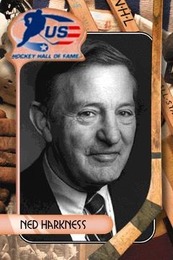



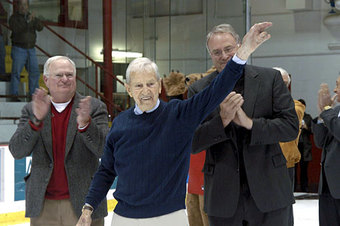

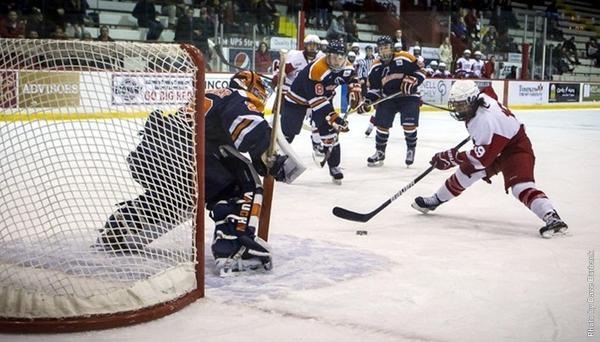
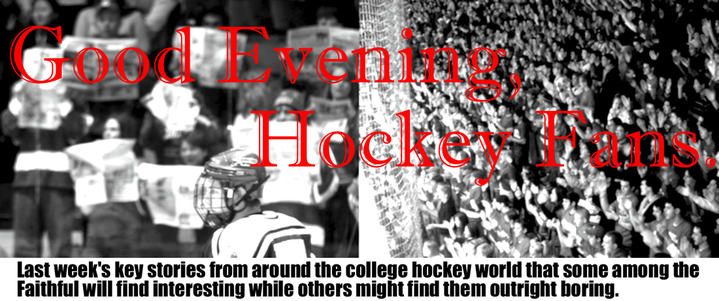








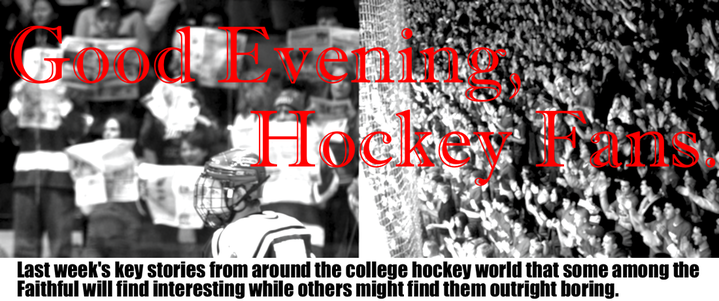

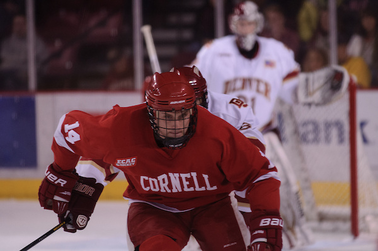
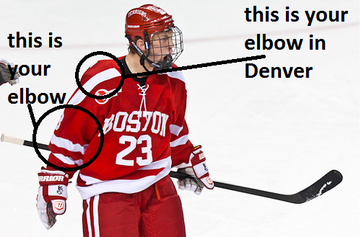






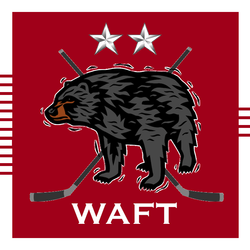

 RSS Feed
RSS Feed
